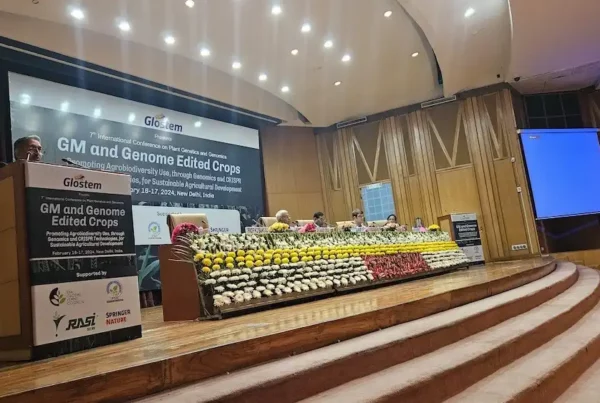Peng Jiang and Hui Guo at the University of Georgia think you can! They are currently raising money via a crowdfunding approach to sequence the first cactus genome – but the question is: why would they want to? Peng explains all in this guest blog post.
A Prickly Proposal: Why Sequence the Cactus?
In these times of growing food insecurity due to climate change and population pressures, the prickly pear cactus (Opuntia ficus) has growing commercial and agricultural importance across much of the world – you will find it growing in Mexico and Brazil, Chile, large parts of India and South Africa, and in Spain and Morocco.
The goal of our proposal is to sequence the genome and transcriptome of the prickly pear cactus, a recognized food and forage crop in these challenging semiarid regions of the world.
With more than 130 genera and 1,500 species of Cactaceae, we will create a draft genomic and transcriptome database that would aid the understanding of this understudied plant family, and provide the research community with valuable resources for molecular breeding and genetic manipulation purposes. Here are some of the reasons why we think a first cactus genome would be so important:
1. Ecological Improvement
The beauty of the drought-tolerance cactus is that it can grow on desert-like wastelands. Nowadays, more than 35% of the earth’s surface is arid or semiarid, making it inadequate for most agricultural uses. Without efforts to curb global warming, “Thermageddon” may hit in 30–40 years time, causing desertification of the US, such that it may become like the Sahara. Opuntia helps create a vegetative cover, which improves soil regeneration and rainfall infiltration into the soil. This cactus genome research may help us to adapt our food crops to a much hotter, drier climate.
2. Food Crops, Feed and Medicine
The fruits of prickly pear cactus are edible and sold in stores under the name “tuna”. Prickly pear nectar is made with the juice and pulp of the fruits. The pads of prickly pears (“Nopalito”) are also eaten as a vegetable. Both the fruits and pads of prickly pears can help keep blood sugar levels stable because they contain rich, soluble fibers. The fruit contains vitamin C and was used as an early cure for scurvy.
Furthermore, there has been much medical interest in the prickly pear plant. Studies [1, 2, 3] have shown that the pectin contained in prickly pear pulp lowers cholesterol levels. Another study [4] found that the fibrous pectin in the fruit may lower a diabetic’s need for insulin. The plant also contains the antioxidant flavonoids quercetin, (+)-dihydroquercetin (taxifolin), quercetin 3-methyl ether (isorhamnetin) and kaempferol, which have a protective function against the DNA damage that leads to cancer.
3. Biofuels in Semiarid Regions
Planting low water use, Crassulacean acid metabolism (CAM; a water saving mode of photosynthesis) biofuel feedstocks on arid and semiarid lands could offer immediate and sustained biogas advantages. Opuntiapads have 8–12% dry matter, which is ideal for anaerobic digestion. With an arid climate, this prevents the need for extra irrigation or water to facilitate the anaerobic digestion process. Requiring only 300 mm of precipitation per year, Opuntiacan produce a large amount of dry matter feedstock and still retain enough moisture to facilitate biogas production. It’s possible to get as much as 2.5 kWh of methane from 1 kg of dry Opuntia.
4. Phylogenetic Importance
Trained botanists and amateurs alike have held cacti in high regard for centuries. The copious production of spines, lack of leaves, bizarre architecture and impressive ability to persist in the harshest environments on Earth are all traits that have entitled this lineage to be named a true wonder of the plant world.
The cacti are one of the most celebrated radiations of succulent plants. There has been much speculation about their age, but progress in dating cactus origins has been hindered by the lack of fossil data for cacti or their close relatives. Through whole genome sequencing, we help will reveal the genomic evolution of Opuntia by comparing this genome with that of other sequenced plant species.
Cacti are typical CAM plants. We will analyse the evolution of CAM genes in the cactus to help reveal the secret of drought tolerance. Furthermore, plant architecture genes and MADS-box gene family members will be analysed to reveal the specific architecture and structure of cactus.
Crowdfunding the Cactus Genome Project
Cactus has several fascinating aspects that are worth exploring, not just for its biology, but also its relevance to humanity and the global environment. We plan to generate a draft genome for Opuntia, and have launched a crowdfunding campaign to help fund this project – we have already raised $2300 USD (46% of what we need), but we only have 15 days to raise the rest. If you would like to help fund this project, please visit our Experiment page at: https://experiment.com/projects/sequencing-the-cactus-genome-to-discover-the-secret-of-drought-resistance.
If we are successful in raising enough money to initiate the Cactus Genome Project, not only will this be the first plant genome to be sequenced in the Cactaceae family, we will be releasing the results to the plant science community through GeneGarden, an ornamental plant genome database. Our citizen science approach is also allowing us to reach out directly to members of the public, creating exciting opportunities for outreach and engagement with plant science.
If you have any further questions, please contact project leader Dr Peng Jiang at pjiang@uga.edu.
This blog post is slightly adapted from a post originally appearing on GigaScience Journal’s GigaBlog. Reproduced and adapted with permission, under a CC-BY license.
References
- Wolfram RM, Kritz H, Efthimiou Y, et al. Effect of prickly pear (Opuntia robusta) on glucose- and lipid-metabolism in non-diabetics with hyperlipidemia – a pilot study. Wien Klin Wochenscr. 2002;114(19–20):840–6.
- Trejo-Gonzalez A, Gabriel-Ortiz G, Puebla-Perez AM, et al. A purified extract from prickly pear cactus (Opuntia fulignosa) controls experimentally induced diabetes in rats. J Ethnopharmacol. 1996;55(1):27–33.
- Fernandez ML, Lin EC, Trejo A, et al. Prickly pear (Opuntia sp.) pectin alters hepatic cholesterol metabolism without affecting cholesterol absorption in guinea pigs fed a hypercholesterolemic diet. J Nutr. 1994;124(6):817–24.
- Frati-Munari AC, Gordillo BE, Altamirano P, et al. Hypoglycemic effect of Opuntia streptacantha Lemaire in NIDDM. Diabetes Care. 1988:11(1):63–66.










